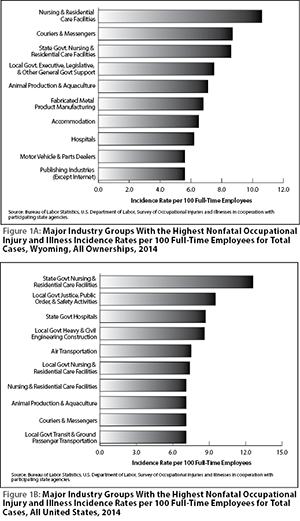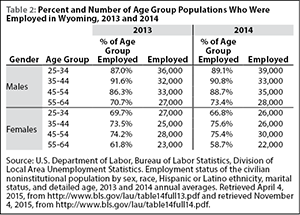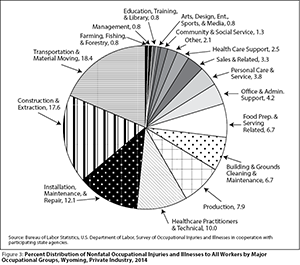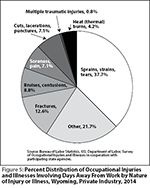
The Survey of Occupational Injuries and Illnesses for 2014
This article summarizes the 2014 Wyoming Survey of Occupational Injuries and Illnesses results. The data include estimates of incidence rates by industry and the nature of the injury or illness. Also included are some worker demographics, such as age and gender. State and local government data are discussed briefly. An estimated 2,390 nonfatal occupational injury and illness cases with days away from work occurred in private industry in Wyoming in 2014, with an incidence rate of 3.5.
The Research & Planning (R&P) section of the Wyoming Department of Workforce Services annually conducts the Survey of Occupational Injuries and Illnesses (SOII) for Wyoming in cooperation with the U.S. Bureau of Labor Statistics (BLS) as part of a nationwide data collection effort. The survey data identify the estimated incidence rates (see Definitions) of work-related injuries and illnesses at the industry level. Detailed characteristics of severe injuries and illnesses (those that result in days away from work-DAFW) are also identified. For 2014, cases with job transfer or restriction for the following six private North American Industry Classification System (NAICS) sectors will also have demographic and injury/illness characteristics provided by employers:
- 312 – Beverage & tobacco product manufacturing
- 452 – General merchandise stores
- 492 – Couriers & messengers
- 562 – Waste management & remediation services
- 622 – Hospitals
- 721 – Accommodation
The data for the cases with days away from work can be used by employers and safety awareness groups to focus on prevention. The data are also used by regulatory agencies for tracking injury and illness trends, and to target safety resources.
Wyoming had an estimated 2,390 occupational injury and illness cases with days away from work in private industry for 2014.
Background and Methodology
For this mandatory survey (see Definitions), 2,388 private and 312 public sector (state and local government) Wyoming employers were notified in December 2013 to keep records of their firms’ work-related injuries and illnesses during calendar year (CY) 2014 using the Occupational Safety & Health Administration (OSHA) 300 forms. Along with data from the original firms sampled, occupational injury and illness data for 187 employers from the mining, except oil & gas; and railroad industries were added from administrative records provided to BLS by two federal agencies: the U.S. Department of Labor, Mine Safety & Health Administration (MSHA) and the U.S. Department of Transportation, Federal Railroad Administration (FRA). In January 2015, public and private employers were sent a pamphlet describing how to transfer data from the OSHA 300 forms to questionnaires available on the Internet or by e-mail.
Employers were asked to respond within 30 days. Two subsequent mailings were sent to non-respondents to increase response rates, after which attempts were made to contact these employers by phone or e-mail to acquire the information. Employers were also contacted to verify or correct data. The data collection periods lasted approximately seven months. After the data collection periods, data and results were reviewed by state, regional, and national BLS staff and incidence rates calculated.
About 10% of the 2,700 original sampled units were determined to be out of scope, had gone out of business since the sample was drawn, had a duplicate record, had no employees in 2014, or otherwise did not meet the criteria for inclusion in the survey. Of the remaining sampled and BLS-provided employers, 93% in 2014 provided useable responses for the survey.
Data were reported by employers on the basis of a single incident or occurrence. If an employee experienced more than one nonfatal work-related injury or illness during the calendar year, each incident was reported separately and is referred to as a case. If an incident injured more than one employee, each employee was reported separately on the questionnaire. For a work-related injury/illness to be categorized as a recordable case:
it results in any of the following: death, days away from work, restricted work or transfer to another job, medical treatment beyond first aid, or loss of consciousness…it involves a significant injury or illness diagnosed by a physician or other licensed health care professional, even if it does not result in death, days away from work, restricted work or job transfer, medical treatment beyond first aid, or loss of consciousness.
For additional information see the OSHA Recordkeeping Rules online here.
Data reported by employers to Worker’s Compensation have a higher number of work-related injuries and illnesses due to having different definitions and requirements than the SOII does. R&P provides data on the number of Worker’s Compensation cases by quarter and historically, which can be found near the bottom of the page at: http://doe.state.wy.us/LMI/safety.htm.
Due to the discrepancies in the numbers of work-related injuries and illnesses reported by both Worker’s Compensation and the SOII, there has been and continues to be research into this undercount. Information on the undercount can be found at: http://www.bls.gov/iif/oshfaq1.htm#q02.
The BLS produces the SOII incidence rate estimates from the gathered data. Incidence rates by industry indicate the number of nonfatal occupational illnesses or injuries per 100 full-time employees. The cases deemed the most serious are those which involve days away from work (DAFW). The BLS counts up to a cap of 180 days away from work per case, even though there are cases with more days. DAFW cases associated with employees who do not require time off work beyond the day of injury are not included as DAFW cases. The number of cases with days of restricted duty or job transfer (DJTR) is counted in the summary of injuries and/or illnesses. Other recordable cases are also counted in the summary of injuries and/or illnesses, which are cases requiring medical treatment beyond first aid but with no lost time, restricted duty, or job transfer days.
Incidence Rates

|
The total estimated incidence rate in Wyoming for all ownerships was 3.7 injuries and illnesses per 100 full-time employees in 2014. The private sector estimated incidence rate was 3.5. The rate for state and local government was 4.4 for 2014. For state government alone, the rate was 3.7; for local government alone, the rate was 4.7.
Figures 1A and 1B show the top 10 industry subsectors in all ownerships with high estimated incidence rates (or those with higher risk) in Wyoming and the United States, respectively for 2014. Four of the 10 top industry subsectors nationally were also found in Wyoming’s top 10 for 2014 (see Figures 1A and 1B). These were nursing & residential care facilities, couriers & messengers, State government Nursing & residential care facilities, and animal production & aquaculture. The six higher risk industry sectors that were unique to Wyoming were: Local government Executive, legislative, & other general government support; fabricated metal product manufacturing; accommodation; hospitals; motor vehicle & parts dealers; and publishing industries, except Internet.
The relative standard error (RSE; see Definitions) computed by BLS was used to calculate the estimates, with a 95% confidence interval. The tables with the RSE’s are available upon request from R&P.
Case and Demographic Data

|
Table 1 shows the number of nonfatal occupational injuries and illnesses by selected characteristics for Wyoming from 2008 to 2014. These data show only cases with days away from work; they do not include cases that resulted solely in job transfer or restricted duty or those that were other recordable cases. There appears to be a general downward trend in the number of cases for each category over the years.
Worker Characteristics
In 2014, males made up 56.1% of Wyoming’s workforce (BLS, 2015a). In the total of private DAFW cases in 2014, 58.6% involved males; which contrasts with the Census of Fatal Occupational Injuries & Illnesses (CFOI) data showing that 91.9% of Wyoming CFOI fatalities in 2014 were males (CFOI, 2015). Females made up 44.2%1 of the private workforce in Wyoming (BLS, 2015a), and 40.2% of workers who became more seriously injured or ill at work in 2014 were females2.

|
Table 2 shows the percentage and number of age group populations by gender (BLS, 2015b) in Wyoming’s workforce during 2013 and 2014. The males had noticeable increases in employment in two age groups: for the 25-34 age group employment went from 36,000 in 2013 to 39,000 in 2014, and for the 45-54 age group employment grew from 33,000 in 2013 to 35,000 in 2014. Within the female age groups, two of them increased: employment in the 35-44 age group increased from 25,000 in 2013 to 26,000 in 2014 and in the 45-54 age group employment grew from 28,000 in 2013 to 30,000 in 2014. R&P research has shown that the number of workplace fatalities is related to changes in overall employment (Manning, 2010). This may also be true for nonfatal occupational injuries and illnesses.

|
Injury and Illness Characteristics
For the year 2014, within the trade, transportation, & utilities industry an estimated 400 males and 210 females had cases with days away from work (see Figure 2). During that year, manufacturing had seven times the number of males (140) than females (20) with cases resulting in days away from work. In contrast, five times the number of females to males had cases with days away from work in the educational & health services industry (300 and 60, respectively). For the leisure & hospitality industry, in 2014 there was almost the same number of males as females (110 and 150, respectively) that had the more severe cases.

|
Two of the major occupational groups, construction & extraction and transportation & material moving had a higher-than-average percentage (35% combined) of total workers with work-related injuries or illnesses in 2014 (see Figure 3). More males than females typically work in these occupational groups. Consequently, more males than females were injured in these types of occupations. These workers included construction laborers (150) and heavy & tractor trailer truck drivers (160). However, more females than males were injured in the major occupational groups of healthcare practitioners & technical, and building & grounds cleaning & maintenance because more females than males were usually employed in occupations such as nursing assistants (50) and maids & housekeeping cleaners (100). The highest percentage of injuries and illnesses by combined age groups in 2014 was for workers age 25-34 and 45-54 (48.5%; see Figure 4).

|

|
For injuries resulting in days away from work, the largest percentage for nature of injury or illness was due to sprains and strains (37.7% in 2014; see Figure 5).
Often the injuries were caused by falling, lifting, twisting and bending, standing or sitting, throwing, or reaching. This suggests that employers should place additional emphasis on sprain and strain prevention.
Summary
From 2013 to 2014, there was not a statistically significant change in the number or incidence rate of Wyoming work-related injuries and illnesses resulting in days away from work for private industry (2,390; 3.4 and 2,390; 3.5, respectively). Overall, males continued to experience work-related injuries and illnesses more frequently than females. This was likely due, in part, to higher ratios of males to females employed in industries with higher incidence rates; the exception was educational & health services. More details on 2014 data, as well as further documentation and historical data are available at http://doe.state.wy.us/LMI/OSH/toc.htm. For more information, contact Valerie A. Davis at (307) 473-3838 or val.davis@wyo.gov.
1Data do not add up to 100% due to rounding.
2Data are not available to determine if the remaining 0.2% of workers who became injured or ill in 2014 were males or females.
References
Bureau of Labor Statistics, Division of Local Area Unemployment Statistics. (2015a). Employment status of the civilian noninstitutional population by sex, age, race, Hispanic or Latino ethnicity, and marital status, 2014 annual averages. Retrieved November 4, 2015, from http://www.bls.gov/opub/gp/pdf/gp14_14.pdf
Bureau of Labor Statistics, Division of Local Area Unemployment Statistics. (2015b). Employment status of the civilian noninstitutional population by sex, race, Hispanic or Latino ethnicity, marital status, and detailed age, 2014 annual averages. Retrieved November 4, 2015, from http://www.bls.gov/lau/table14full14.pdf
Census of Fatal Occupational Injuries and Illnesses, Wyoming. (2015). Retrieved November 4, 2015, from http://doe.state.wy.us/LMI/CFOI/toc.htm
Manning, P. (2010). “Employment Change and Impacts on Workplace Fatalities in Wyoming.” (August, 2010). Wyoming Department of Employment, Research & Planning, Casper: WY. Retrieved November 4, 2015, from http://doe.state.wy.us/LMI/safety/CFOI_Reg_Model_2010.pdf